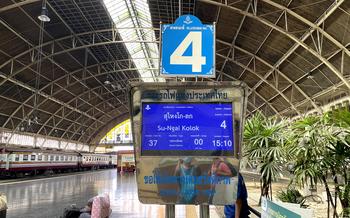
Little Amazon Ranong (Sang Nae Canal)
- Ranong: Gateway to Southern Thailand's Natural Wonders
- Exploring the Canal by Long-Tailed Boat
- Mangrove Forests and Their Significance
- Spotting Wildlife in the Canal
- Visiting Local Villages Along the Canal
- Floating Markets and Local Delicacies
- Kayaking Adventures in the Canal
- Hiking Trails and Nature Walks
- Cultural and Historical Sites
- Local Festivals and Events
- Shopping and Local Products
- Planning Your Trip to Ranong
- Insider Tip: Hidden Gems and Local Secrets
Ranong: Gateway to Southern Thailand's Natural Wonders
nestled in the southern region of Thailand, Ranong is a province brimming with natural beauty and cultural charm. It serves as a gateway to the region's unspoiled landscapes, including the mesmerizing Sang Nae Canal, also known as the Little Amazon Ranong. Ranong's rich history dates back to the days of the ancient Kingdom of Ligor, leaving behind a legacy of cultural heritage and traditions.
Getting to Ranong is a breeze, with various transportation options available. Travelers can take a scenic train ride from Bangkok, enjoying the picturesque countryside views along the way. Alternatively, buses and minivans offer a more budget-friendly option, connecting Ranong to major cities in Thailand. Once in Ranong, finding accommodation to suit every budget is easy, from cozy guesthouses to luxurious resorts nestled amidst tropical greenery.
Exploring the Canal by Long-Tailed Boat
To fully experience the charm of the Sang Nae Canal, hiring a long-tailed boat is a must. These traditional wooden boats, with their distinctive elongated stern, are expertly maneuvered by local boatmen through the narrow waterways. Negotiate a fair price before embarking, keeping in mind that the journey typically lasts for around an hour.
As the boat glides along the tranquil waters, immerse yourself in the serene beauty of the surroundings. Observe the lush mangrove forests lining the banks, casting intricate reflections on the glassy surface. Keep an eye out for wildlife, as the canal is home to a diverse array of birds, reptiles, and even the occasional mammal. Capture the stunning scenery with your camera, ensuring you have enough memory space to store all the breathtaking shots.
Mangrove Forests and Their Significance
The Sang Nae Canal is home to a variety of mangrove species, each playing a vital role in the ecosystem. Mangrove forests act as natural barriers, protecting coastlines from erosion and storm surges. Their intricate root systems trap sediment and stabilize the shoreline, preventing soil loss and mitigating the impact of waves and tidal currents.
Mangroves provide a haven for a diverse range of wildlife. Their dense roots create a complex habitat, offering shelter and breeding grounds for fish, crustaceans, and mollusks. The leaves and fruits of mangrove trees serve as a food source for various bird species, including egrets, herons, and kingfishers. These forests also support reptiles, amphibians, and mammals, such as mudskippers, monitor lizards, and otters.
Beyond their ecological significance, mangroves have immense economic and social value. Local communities rely on mangrove forests for sustenance and livelihoods. They collect fish, shellfish, and crabs from the mangrove waterways, and utilize mangrove wood for construction and fuel. Mangroves also contribute to carbon sequestration, helping to mitigate climate change.
Conservation efforts are underway to protect and restore mangrove forests in the Sang Nae Canal and throughout Thailand. Reforestation projects aim to increase mangrove cover and combat deforestation. Education and awareness programs promote the importance of mangroves and encourage sustainable practices among local communities. By preserving these vital ecosystems, we can ensure their continued benefits for both nature and humanity.
Spotting Wildlife in the Canal
The Sang Nae Canal is a haven for wildlife enthusiasts, offering a chance to encounter a diverse array of fascinating creatures in their natural habitat. As you glide along the tranquil waters, keep your eyes peeled for the many bird species that call the canal home. From the vibrant kingfishers diving for fish to the majestic brahminy kites soaring overhead, the canal is a birdwatcher's paradise.
Reptiles and amphibians are also abundant in the canal. Monitor lizards bask in the sun on the riverbanks, while tree frogs and geckos can be spotted among the lush vegetation. If you're lucky, you might even catch a glimpse of a shy otter darting through the water or a water monitor lizard stealthily hunting for prey.
For those interested in mammals, the canal is home to a variety of species, including macaques, gibbons, and the elusive binturong, also known as the bearcat. These creatures can often be seen foraging for food or swinging through the trees, offering a glimpse into the rich biodiversity of the area.
To enhance your wildlife viewing experience, consider hiring a local guide who can help you spot and identify the different species. Remember to practice responsible wildlife viewing by maintaining a respectful distance and avoiding disturbing the animals in their natural habitats. With a little patience and luck, you're sure to encounter some of the amazing wildlife that the Sang Nae Canal has to offer.
Visiting Local Villages Along the Canal
Venturing beyond the tranquil waters of the Sang Nae Canal, you'll encounter charming villages nestled along its banks, offering a glimpse into the vibrant local culture. These communities are home to warm and welcoming people who are eager to share their traditions and way of life with visitors.
As you approach the villages, you'll be greeted by friendly smiles and invitations to explore their homes and businesses. Take the opportunity to engage with the locals, learn about their customs, and support their livelihoods by purchasing handmade souvenirs and local products.
Respecting local customs is essential when visiting these villages. Dress modestly, remove your shoes before entering homes, and ask permission before taking photographs. Your genuine interest and respect will be greatly appreciated by the villagers, who will happily share their stories and experiences with you.
Don't miss the chance to savor delicious home-cooked meals prepared with fresh local ingredients. Sample traditional Thai dishes and snacks, often prepared using unique recipes passed down through generations. Your taste buds will delight in the authentic flavors and aromas of these culinary creations.
As you bid farewell to the villagers, you'll carry with you fond memories of their warmth and hospitality. Their genuine smiles and the memories you've made together will serve as a reminder of the rich cultural heritage that thrives along the banks of the Sang Nae Canal.
Floating Markets and Local Delicacies
The Sang Nae Canal is home to several floating markets, where visitors can immerse themselves in the vibrant local culture and savor a variety of delicious Thai dishes. These markets offer a unique experience, as vendors sell their wares from boats, creating a lively and colorful atmosphere.
Must-try dishes include khao soi, a northern Thai noodle soup with rich coconut milk broth, and pad see ew, a stir-fried noodle dish with soy sauce and vegetables. For a sweet treat, try khanom buang, a crispy crepe filled with sweet coconut custard.
To interact with the vendors, it's important to be polite and respectful. Bargaining is acceptable, but always do so in a friendly and good-humored manner. Show your appreciation by supporting local businesses and purchasing handmade souvenirs, which are often made by skilled artisans using traditional techniques.
Kayaking Adventures in the Canal
For a more intimate and immersive experience, consider renting a kayak and exploring the Sang Nae Canal at your own pace. Kayaking offers a unique perspective, allowing you to glide silently through the tranquil waters and get up close to the lush mangrove forests and their inhabitants.
The canal is relatively calm and easy to navigate, making it suitable for paddlers of all skill levels. Several kayak rental shops are located in Ranong town, and you can arrange for a kayak to be delivered to the starting point of your choice.
Kayaking in the Sang Nae Canal offers several advantages. Firstly, it provides a flexible and independent way to explore the canal. You can paddle at your own pace, stop whenever you like to take photos or observe wildlife, and choose your own route.
Secondly, kayaking is a peaceful and serene activity that allows you to connect with nature and appreciate the tranquility of the canal. The gentle paddling motion and the sound of the water lapping against the kayak create a sense of tranquility that is hard to find elsewhere.
Finally, kayaking offers the opportunity for up-close encounters with the local wildlife. As you paddle through the mangroves, you may encounter birds, reptiles, and even small mammals that come to the water's edge. Kayaking provides a unique perspective from which to observe these creatures in their natural habitat.
For a memorable kayaking experience, consider paddling to one of the many hidden coves or inlets along the canal. These secluded spots are ideal for a picnic lunch or simply relaxing and soaking up the beauty of the surroundings.
Hiking Trails and Nature Walks
In addition to exploring the Sang Nae Canal by boat, visitors can immerse themselves in the natural beauty of the surrounding area by embarking on hiking trails and nature walks. The vicinity of the canal offers a range of trails suitable for varying fitness levels and interests. These trails wind through lush forests, lead to scenic viewpoints, and offer opportunities to encounter hidden gems such as waterfalls and serene natural pools.
Before embarking on a hike, it's essential to pack appropriately. Comfortable shoes, insect repellent, and a hat are recommended. It's also advisable to bring water, snacks, and a camera to capture the breathtaking scenery along the way.
For those seeking a leisurely stroll, the canal's banks provide a flat and accessible path, ideal for a relaxing walk while enjoying the tranquil surroundings. For a more challenging experience, trails that venture deeper into the forest offer steeper terrain and more strenuous hikes.
One popular trail leads to a stunning viewpoint overlooking the canal and the surrounding landscape. The panoramic views from this vantage point are truly breathtaking, making it a worthwhile destination for those willing to make the effort.
For those seeking a more immersive experience, guided nature walks are available, led by knowledgeable local guides who can share insights into the local flora and fauna. These walks offer a unique opportunity to learn about the diverse ecosystem of the area and spot wildlife in their natural habitat.
Cultural and Historical Sites
Ranong province is home to a wealth of cultural and historical landmarks that offer a glimpse into its rich past and heritage. History buffs and culture enthusiasts will find plenty to explore, from ancient temples and museums to historic sites that played a role in shaping the region's identity.
One must-visit attraction is the Wat Khao Jong Temple, which is perched on a hilltop and offers panoramic views of the surrounding landscape. The temple is known for its intricate murals and sculptures, which depict scenes from Buddhist mythology and history. Another must-see is the Ranong Provincial Museum, which houses a collection of artifacts and exhibits that showcase the province's cultural heritage, including traditional costumes, tools, and handicrafts.
For those interested in World War II history, the Burma Road is a significant landmark that served as a vital supply route for Allied forces during the war. The road, which was built by Allied engineers and local laborers, is a testament to the resilience and determination of the people of Ranong.
When visiting cultural and historical sites in Ranong, it is important to be respectful of local customs and traditions. Dress modestly, remove your shoes before entering temples, and avoid touching or taking photos of religious objects without permission.
Local Festivals and Events
Ranong province is alive with vibrant festivals and events that celebrate its rich cultural heritage and local traditions. These events offer visitors a unique opportunity to immerse themselves in the local way of life and experience the warm hospitality of the Ranong people.
The Ranong Fruit Festival, held annually in May or June, is a must-attend event for fruit lovers. The festival showcases the province's abundant tropical fruits, including rambutans, mangosteens, and durians. Visitors can indulge in fresh fruits, fruit-based dishes, and fruit-themed activities, making it a delightful and flavorful experience.
Another highlight is the Ranong International Food Festival, usually held in October or November. This culinary extravaganza brings together renowned chefs and food enthusiasts from around the world to showcase their talents and share their culinary creations. Visitors can savor a diverse range of dishes, from traditional Thai cuisine to international delicacies, while enjoying live music and cultural performances.
For those interested in history and culture, the Ranong Cultural Festival, held in March or April, offers a glimpse into the province's fascinating past. The festival features traditional dance performances, music shows, and exhibitions that showcase Ranong's unique customs and traditions. Visitors can also participate in hands-on activities and workshops to learn more about local crafts and traditions.
These festivals provide an excellent opportunity to connect with the local community, experience the vibrant energy of Ranong, and create lasting memories of your visit to this charming province.
Shopping and Local Products
Ranong offers a delightful shopping experience, showcasing a range of local products and handicrafts that reflect the region's rich cultural heritage. Strolling through the town's markets and shops, visitors can discover a treasure trove of unique souvenirs and gifts to take home.
One of the must-buy items in Ranong is the exquisite Ranong mat. Handcrafted by skilled artisans using natural fibers, these intricate mats are known for their durability, intricate designs, and vibrant colors. Visitors can choose from a variety of sizes and patterns, making them a perfect addition to any home décor.
For those seeking a taste of local flavors, Ranong's markets offer an array of dried seafood delicacies. From succulent squid and shrimp to flavorful fish and shellfish, these dried seafood products are a testament to the region's rich marine resources. Visitors can purchase these delicacies as souvenirs or enjoy them as a culinary treat.
Another popular local product is Ranong coffee. Grown in the province's fertile highlands, Ranong coffee is renowned for its rich aroma and smooth taste. Visitors can indulge in a cup of freshly brewed Ranong coffee at local cafes or purchase roasted beans to savor at home.
When it comes to bargaining, visitors are encouraged to embrace the friendly and respectful nature of the local culture. Politely asking for a fair price and engaging in friendly conversation with vendors can often lead to successful negotiations and a memorable shopping experience.
By supporting local artisans and purchasing their handcrafted products, visitors not only take home unique souvenirs but also contribute to the preservation of Ranong's cultural heritage and the livelihoods of its people.
Planning Your Trip to Ranong
When planning your trip to Ranong, consider spending at least two to three days to fully immerse yourself in the natural wonders and cultural experiences the province offers. Pack light, comfortable clothing suitable for outdoor activities and remember your swimsuit for a dip in the hot springs. Don't forget your camera to capture the stunning scenery and wildlife encounters.
To navigate language barriers, learn a few basic Thai phrases or download a translation app. The local currency is the Thai Baht (THB), and you can easily exchange currency at banks or exchange bureaus in Ranong town. Embrace the local culture by respecting customs and traditions, such as removing your shoes before entering temples and dressing modestly when visiting religious sites.
For internet access, SIM cards with data packages are readily available at local mobile phone shops. Stay connected with family and friends back home by purchasing a local SIM card or using Wi-Fi hotspots in hotels, restaurants, and public areas.
Insider Tip: Hidden Gems and Local Secrets
Unveil the hidden gems of Ranong and the Sang Nae Canal to enhance your travel experience. Venture beyond the main tourist spots to discover secluded beaches, tranquil waterfalls, and lesser-known viewpoints. Ask locals for recommendations on secret spots where you can enjoy a peaceful picnic or simply relax by the water's edge.
For photography enthusiasts, capture the stunning beauty of the canal during the golden hours of sunrise and sunset. Explore the canal's tributaries to discover hidden mangrove forests and unique wildlife sightings. Remember to respect the natural environment and minimize your impact on the delicate ecosystem.
Immerse yourself in the local culture by visiting the night markets in Ranong town. Sample delicious street food, shop for unique souvenirs, and interact with friendly locals. Respect local customs and dress modestly when visiting temples and sacred sites.
To fully appreciate the beauty of the Sang Nae Canal, consider staying overnight in one of the floating bungalows or guesthouses along the waterway. This unique experience allows you to witness the tranquil ambiance of the canal at night and wake up to the sounds of nature.
Make the most of your Ranong adventure by exploring beyond the beaten path. Embrace the local culture, seek out hidden gems, and create unforgettable memories in this serene and unspoiled corner of Thailand.




